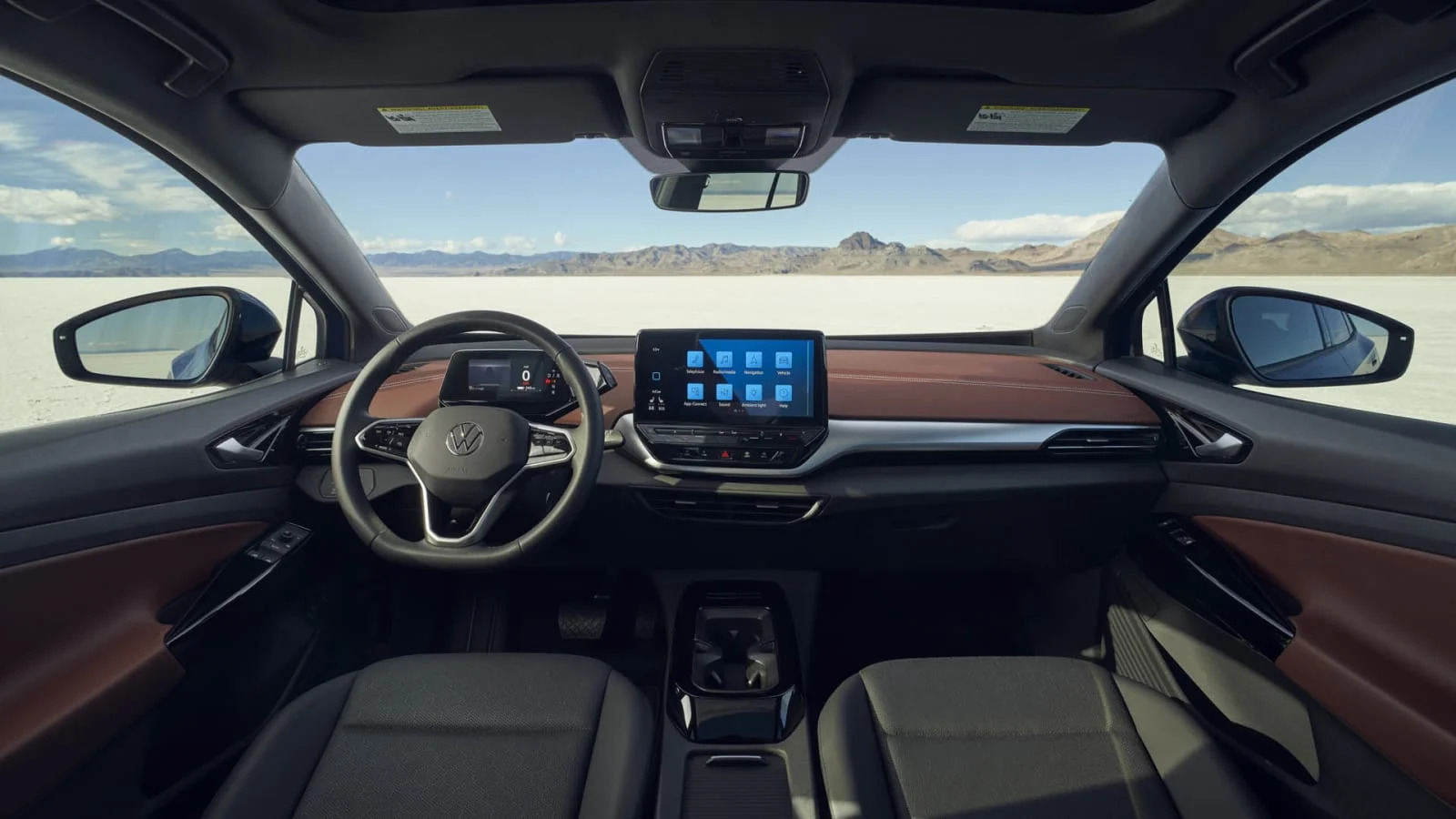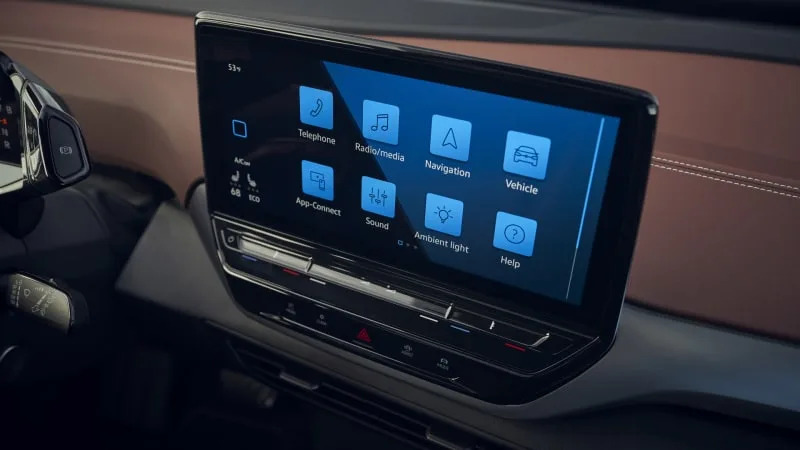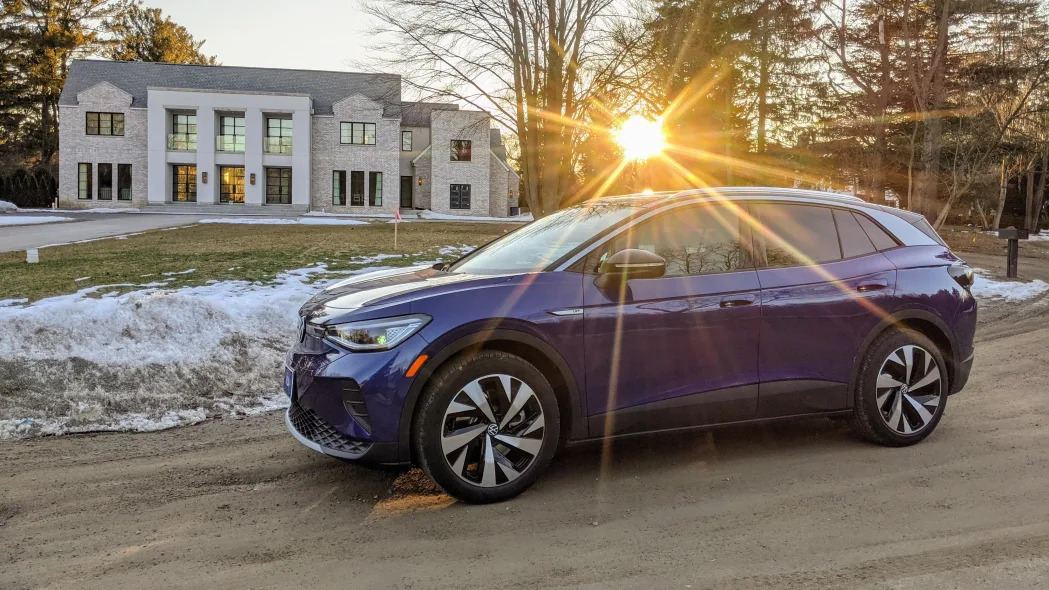-
TrimFirst Edition
-
Enginepermanent magnetic motor
-
Power201 HP / 229 LB-FT
-
TransmissionSingle gear
-
DrivetrainRWD
-
Engine PlacementRear
-
Curb Weight4,665 LBS
-
Towing2,200 LBS
-
Seating2+3
-
Cargo64.2 cu ft
-
MPG97 MPGe combined
-
As Tested Price$45,190
The 2021 Volkswagen ID.4 is refreshingly and unapologetically a crossover for the masses that happens to be an electric car. This stands in contrast to two of its key competitors. First and foremost, the Mach-E is a Ford Mustang and the Model Y is a Tesla. While those names add distinction, they also add expectations.
VW is more than happy to benchmark the ID.4 against such proletarian vehicles as the Honda CR-V and Toyota RAV4. Not coincidentally, Honda and Toyota sell hundreds of thousands of those. That’s the idea for Volkswagen, which hopes the ID.4 and its upcoming siblings will transform the company the way the Golf did in a different era. Put simply, it’s a business decision.
But let’s not sell the ID.4 short. It’s an attractive and highly capable EV, offering 250 miles of range, rear-wheel drive (AWD is an option) and a decent amount of cargo space. It’s the right formula, plus it provides an enjoyable driving experience.
The ID.4 puts out 201 hp and 229 lb-ft of torque through a motor powered by an 82-kilowatt-hour (gross total) lithium-ion battery pack. A more powerful battery pack will come later this year with all-wheel drive. The electric motor is mounted right over the rear axle, and the low center of gravity means it handles unexpectedly well. I did not see myself pushing the ID.4 through Interstate 75’s long onramps in Detroit’s north suburbs, but hey, it’s never a bad thing when a car turns out to be more fun than advertised.
Considering this, I lay on the throttle and make my way through traffic, emboldened by the Sport Mode and challenged by rush hour traffic, the ID.4 becomes an object of my curiosity. "What can this thing do?" I wonder, as daylight slips and I pass through Auburn Hills, the one-time home of Volkswagen of America. A few rounds of hard acceleration cure me of any illusions of the ID.4 as a performance-oriented machine, but there’s enough on offer so as to be compelling at suburban stoplights. I meander around an iced-over lake before heading back toward more densely populated areas. The steering is light yet direct. The suspension (strut front, multilink rear) is tuned for comfort, and March in Michigan brings pockmarked roads and potholes that sink to unknown depths. More than once I figure my fillings will be jarred, but the ID.4 absorbs without being rolling Novocaine. In normal driving, the regenerative brakes are less noticeable than other EVs and there’s a lot of pedal travel, giving the ID.4 a conventional stopping feel. To dial up more regeneration, drivers can shift to a Brake mode.
My drive took an hour and 39 minutes covering 54 miles, dropping the charge from about 85% to 59%. I briefly charged that evening using VW’s lightweight and easy-to-use Level 1 mobile charger that’s stored below the rear cargo area. Unpacking the charger, I took note of the ample space in the back. The ID.4 has 30.3 cubic feet of cargo room behind the second row, which is best among its electric competitors from Chevy, Ford, Hyundai and Nissan (Tesla does not publish a similar volume number for the Model Y). The ID.4's volume is on the small side among compact crossovers, however, and roughly what you'd get (at least on paper) in a Mazda CX-5. The Honda CR-V and Toyota RAV4 have appreciably more.
The trim breakdown is pretty simple. The base ID.4 is called Pro. Starting at $41,190, including $1,195 for destination, it’s nicely equipped with standard LED head- and taillights, illuminated door handles, 19-inch aluminum alloy wheels, a heated steering wheel and heated cloth seats. It also has VW’s driver assistance suite, which includes lane centering, forward collision warning and automatic emergency braking.
The Pro S ($45,690) adds a panoramic glass roof that opens up the interior, heated leatherette seats, a 12-inch center display and a power tailgate. At this point the ID.4 is treading into premium territory. Add the $1,500-Gradient Package (black roof, silver accents, 20-inch-wheels) and all-wheel drive ($3,680 option) and suddenly you have a $50,870-Volkswagen compact crossover. That said, Volkswagen has an ample supply of $7,500 federal tax credits that can be applied, and many states offer additional incentives, meaning that in general, the ID.4 can get much more affordable quickly.



I tested an ID.4 First Edition stickering for $45,190, including shipping charges. The package adds mainly cosmetic changes, including First Edition fender badges, a First Edition welcome screen and a tow hitch. The steering wheel, the steering column and the armrests are white, which lightens up the interior. The clean aesthetic is reminiscent of some of VW’s past concept vehicles. The First Edition includes the Gradient pack and is only available in rear-wheel drive, simply because those are the first models that are coming off the line. It’s actually $500 cheaper than the top trim, Pro S, because you lose the lighted VW logo, which is a design flourish I would favor over the minor First Edition add-ons.
The ID.4 is a reasonable value, especially at the basic Pro level. But, many buyers will require all-wheel drive and some upgrades, and a Pro S with AWD comes in at $49,370. Yes, electric cars are relatively expensive right now, but the Mach-E and Model Y advertise the buyer’s green leanings to the rest of the world. Or, perhaps more accurately for some buyers, their sense of style and brand awareness. Either way, the ID.4 is more anonymous. I also had a Tiguan R-Spec at the same time as the ID.4. With blacked-out wheels and plenty of brightwork, that was the VW that stood out in my neighborhood.
There's an increasing number of somewhat similar vehicles in the crossover electric space. The Mach-E and Model Y are flashier than the ID.4. On the other hand, Volkswagen's electric car could suggest premium but not pretentious thinking. When VW is doing things right, that’s what separates it from Chevy, Nissan and Hyundai, which are also in this electric space.
In the final analysis, the ID.4 is a competitive EV, but the Mach-E feels more special and the Model Y, is well, a Tesla. That might sound trite, but those things matter right now as electrification achieves greater adoption and consumers change their thinking. VW is blending in with a nicely executed vehicle, but it does not have the gravitas to take share away from Ford or Tesla. That said, the ID.4 is cheaper. Saving a few grand could sway entry-level EV buyers, and that's a smart play. Volkswagen made a business decision to make the ID.4 a little more mainstream. It might pay off with broad acceptance as the market grows, but might also get lost in the electric shuffle.




















Sign in to post
Please sign in to leave a comment.
Continue